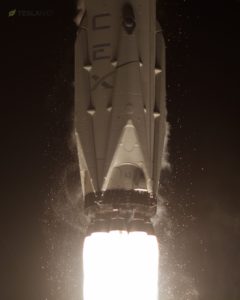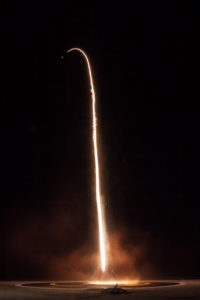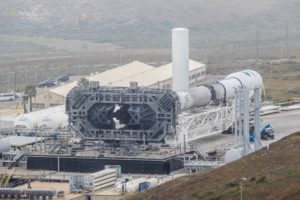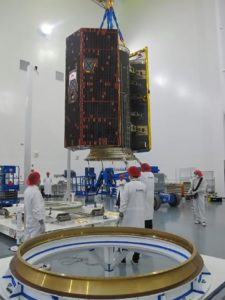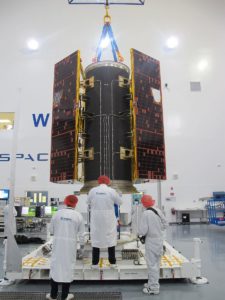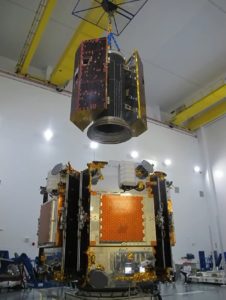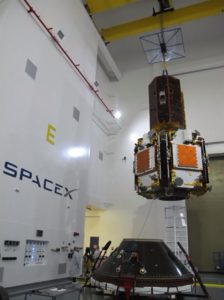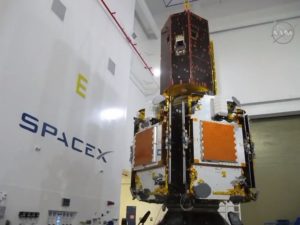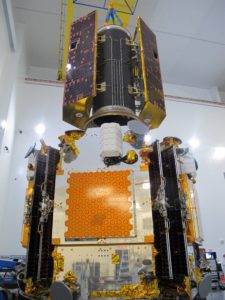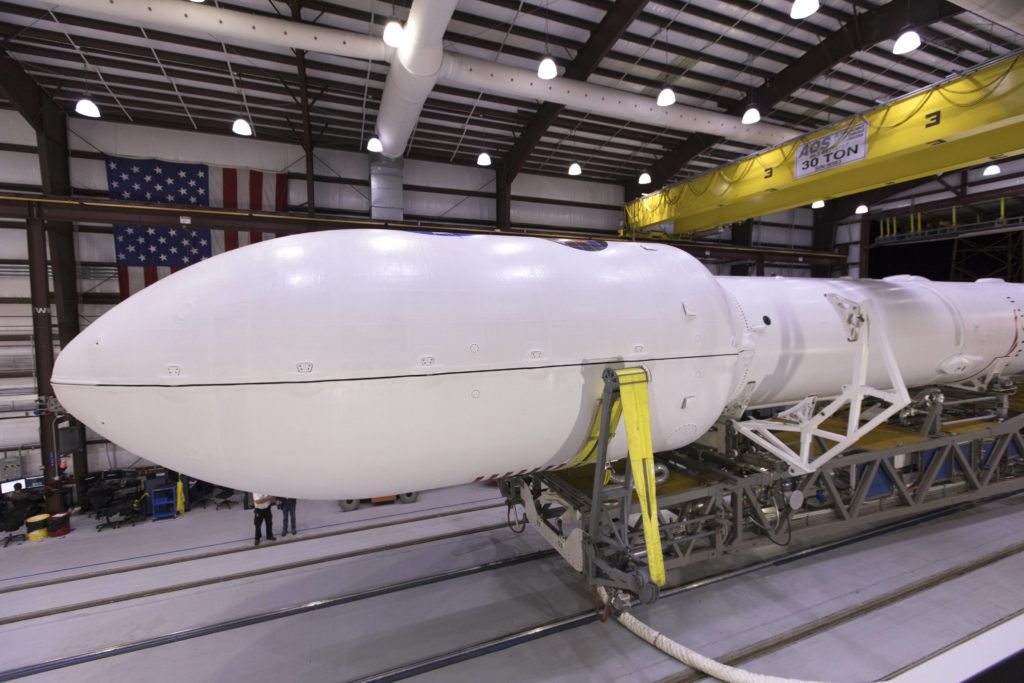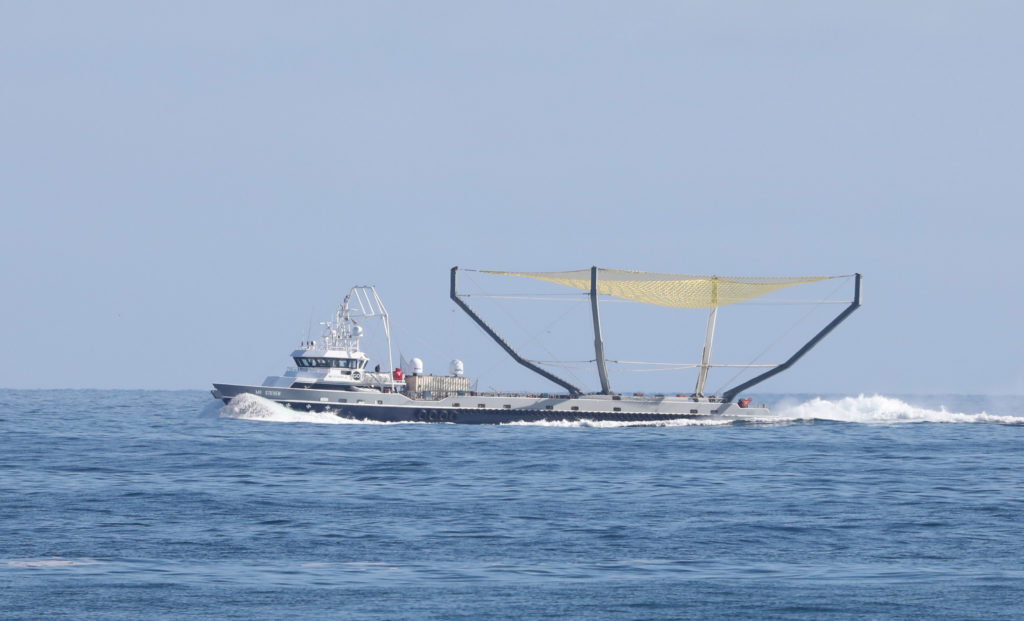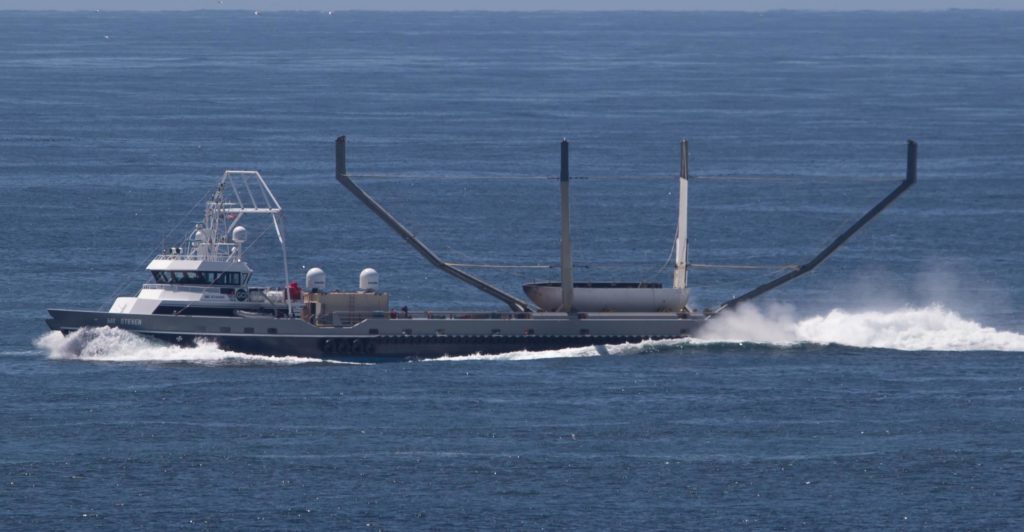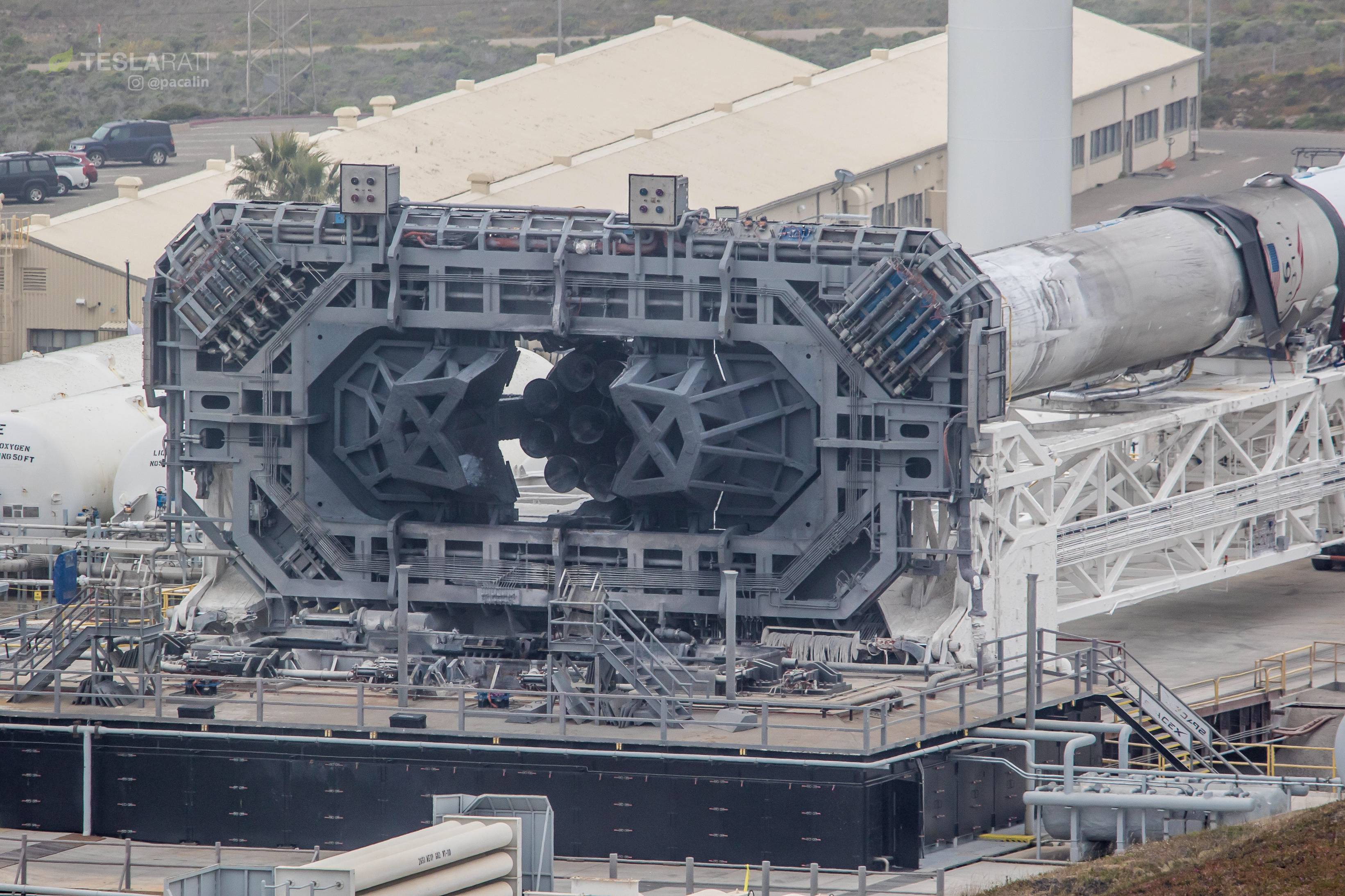

News
SpaceX to launch one of its last old-gen Falcon 9s in upcoming launch
One of SpaceX’s rapidly shrinking fleet of older Falcon 9 launch vehicles has rolled out to the company’s California launch pad ahead of an expendable launch and fairing recovery attempt scheduled for no earlier than Tuesday (NET) 12:47 pm PST/19:47 UTC May 22.
Although SpaceX may have inaugurated a new era of truly reusable rocketry with the debut of Falcon 9 Block 5 earlier this month, there are still a number of older Falcon 9 boosters (all flight-proven) awaiting their second and final flights. At the moment, a minimum of four cores remain, including the sooty Falcon 9 first stage captured earlier this evening by Teslarati photographer Pauline Acalin.
Foreshadowing its imminent watery demise with a lack of landing legs, this particular booster (B1043) previously launched the mysterious and controversial Zuma mission in January 2018, a classified payload claimed (sans convincing evidence) to have failed and reentered Earth’s atmosphere mere hours after reaching orbit. While it’s possible that the mission was a failure, at the moment unsteadily blamed on the failure of a Northrop Grumman-designed payload adapter and deployment mechanism, it’s far more probable that the apparently wildly-expensive satellite is still in orbit.
- Falcon 9 B1043 lifts off for the first time with Zuma on January 7. (Tom Cross/Teslarati)
- After landing at LZ-1, B1043 was refurbished in approximately four months. (SpaceX)
- On May 21, the rocket was rolled out to SLC-4E on the opposite coast of its first launch, ready for one final flight. (Pauline Acalin)
Checking the pulse of Earth’s gravity
Regardless, the same SpaceX rocket booster responsible for lifting Zuma and the Falcon 9 upper stage out of the atmosphere is now ready to launch a new payload at SLC-4E, a launch pad stationed in Vandenberg Air Force Base. B1043’s second orbit-destined payload is a compliment of seven satellites: five are of the Iridium NEXT variety and the remaining satellites make up a scientific mission and technology demonstrator known as GRACE-FO (FO for Follow-On).
- The two GRACE-FO satellites are stacked atop five Iridium NEXT communications satellites. (NASA)
- (NASA)
- (NASA)
- SpaceX is already fairly experienced with launching multi-satellite missions and building custom payload adapters. (NASA)
- A combination of scientific satellites and five Iridium NEXT communications satellites preparing for launch in May 2018. (NASA)
- During a normal Iridium NEXT launch, two groups of five satellites are stacked on top of each other. Here, the top stack was replaced by NASA/DLR’s GRACE-FO spacecraft. (NASA)
Following in the footsteps of the original GRACE’s (Gravity Recovery and Climate Experiment) 15 year orbital tenure, GRACE-FO is effectively the same mission with significantly upgraded hardware – the biggest experimental component is actually an advanced laser interferometer designed to measure the distance between the two satellites (roughly equivalent to the distance between LA and San Diego) with the precision of a single micrometer (10-100x smaller than the width of a human hair). At that level of precision, the pair of satellites can detect minute changes in Earth’s gravity, to the extent that they can actually observe droughts, floods, and ice melt through the change in gravity caused by the movement of large (i.e. heavy) quantities of water. If the experimental laser ranging technology works as intended, it will be at least ten times more accurate than the microwave-ranging technology also installed on the follow-on satellites.
SpaceX’s rocket fleet makes way for Block 5
On the SpaceX side of things, Falcon 9 B1043 will be expended after dutifully completing the launch of Iridium-6/GRACE-FO, although the presence of grid fins on the rocket indicates that SpaceX will likely continue a regime of soft-landing recovery tests to optimize and flesh out the limits of Falcon 9’s capabilities. At first glance, the tradeoff of expending entire rocket boosters able to be (relatively inefficiently) refurbished for considerably more than two flights seems extreme and inadvisable. However, SpaceX is presumably ravenous for data on the survivable envelope of Falcon 9 performance – particularly reuse – in advance of the complete transition to the rocket’s Block 5 iteration, a significant upgrade likely to come hand in hand with a more pronounced aversion to expendable missions given each booster’s design lifespan of 10 to 100 missions. At that level of reusability, expending Falcon 9 Block 5s would truly become comparable with the absurdity of trashing an airliner after one or a handful of flights, an (in)famous talking point used by Elon Musk over his years of public SpaceX discussions.
Thus, if SpaceX can gather data that might enable future Falcon 9 Block 5 recoveries by expending much less valuable Block 3 and 4 boosters, the payoff would be irresistible once examined with a long-term outlook. In the sense that Block 5 may be capable of magnitudes more flights with considerably cheaper refurbishment, the literal elemental value of the hardware – in the likely event that Block 5 production is more capital-intensive than Block 3/4 – is more or less irrelevant for an aversion to expending Block 5 boosters.
Rather, what is lost alongside an expendable Block 5 mission is instead the comparatively vast amount of revenue locked within dozens of additional highly-profitable launches each expended booster could have supported. From that perspective, expending Block 3s and 4s to gather data might be accurately compared to destroying single-pilot Cessnas to improve the utility of a 747 airliner.
After B1043 is expended, only three obvious flightworthy cores will remain outside of the gradually growing Falcon 9 Block 5 fleet (just two boosters, currently). In order of anticipated launch, these three missions are SES-12 (NET May 31), CRS-15 (NET June 28), and the Crew Dragon in-flight abort test (NET Q4 2018). Barring the unexpected refurbishment of an older flight-proven core for a third mission, these final three missions will bring to a close the inherently temporary era of partially-reusable SpaceX rockets – in the words of Elon Musk, Block 5 would thus signify that SpaceX has moved from “the dog that caught the bus” to, perhaps, the dog that caught the bus and then learned how to drive and maintain it. Somewhere in the middle of those final throes of old-guard Falcons will be an ever-increasing cadence of Block 5 launches and re-launches, likely including the first manifest-necessitated reuse of a Block 5 booster sometime this summer.
- Falcon 9 B1045 shows off its own Fairing 2.0 ahead of the launch of TESS. (NASA)
- Chuck Bennett captured Mr Steven conducting high-speed maneuvers with its new, yellow net installed, May 17. (Charles Bennett/@chuckbennett)
- Not nearly enough net, as it turned out. (Pauline Acalin, May 2018)
Meanwhile, despite the sealed fate of the rocket’s booster, tomorrow’s launch will debut fairing-catcher Mr Steven’s new and improved net. With the introduction of an upgraded net and what can only be described as back-to-back days of relentless ocean-going practice over the last two weeks, it’s entirely possible that Iridium-6/GRACE-FO will be able to lay claim to the first successful catch of a payload fairing following an orbital rocket launch. Fingers crossed.
Follow the mission live on SpaceX’s webcast at 12:30 pm PST on Tuesday, May 22, and make sure to check back at Teslarati over the course of the week as photographer Pauline Acalin covers Mr Steven’s return to Port of San Pedro.
Follow us for live updates, behind-the-scenes sneak peeks, and a sea of beautiful photos from our East and West coast photographers.
Teslarati – Instagram – Twitter
Tom Cross – Twitter
Pauline Acalin – Twitter
Eric Ralph – Twitter
Elon Musk
Tesla begins expanding Robotaxi access: here’s how you can ride
You can ride in a Tesla Robotaxi by heading to its website and filling out the interest form. The company is hand-picking some of those who have done this to gain access to the fleet.

Tesla has begun expanding Robotaxi access beyond the initial small group it offered rides to in late June, as it launched the driverless platform in Austin, Texas.
The small group of people enjoying the Robotaxi ride-hailing service is now growing, as several Austin-area residents are receiving invitations to test out the platform for themselves.
The first rides took place on June 22, and despite a very small number of very manageable and expected hiccups, Tesla Robotaxi was widely successful with its launch.
Tesla Robotaxi riders tout ‘smooth’ experience in first reviews of driverless service launch
However, Tesla is expanding the availability of the ride-hailing service to those living in Austin and its surrounding areas, hoping to gather more data and provide access to those who will utilize it on a daily basis.
Many of the people Tesla initially invited, including us, are not local to the Austin area.
There are a handful of people who are, but Tesla was evidently looking for more stable data collection, as many of those early invitees headed back to where they live.
The first handful of invitations in the second round of the Robotaxi platform’s Early Access Program are heading out to Austin locals:
I just got a @robotaxi invite! Super excited to go try the service out! pic.twitter.com/n9mN35KKFU
— Ethan McKanna (@ethanmckanna) July 1, 2025
Tesla likely saw an influx of data during the first week, as many traveled far and wide to say they were among the first to test the Robotaxi platform.
Now that the first week and a half of testing is over, Tesla is expanding invites to others. Many of those who have been chosen to gain access to the Robotaxi app and the ride-hailing service state that they simply filled out the interest form on the Robotaxi page of Tesla’s website.
That’s the easiest way you will also gain access, so be sure to fill out that form if you have any interest in riding in Robotaxi.
Tesla will continue to utilize data accumulated from these rides to enable more progress, and eventually, it will lead to even more people being able to hail rides from the driverless platform.
With more success, Tesla will start to phase out some of the Safety Monitors and Supervisors it is using to ensure things run smoothly. CEO Elon Musk said Tesla could start increasing the number of Robotaxis to monitors within the next couple of months.
Elon Musk
Tesla analyst issues stern warning to investors: forget Trump-Musk feud

A Tesla analyst today said that investors should not lose sight of what is truly important in the grand scheme of being a shareholder, and that any near-term drama between CEO Elon Musk and U.S. President Donald Trump should not outshine the progress made by the company.
Gene Munster of Deepwater Management said that Tesla’s progress in autonomy is a much larger influence and a significantly bigger part of the company’s story than any disagreement between political policies.
Munster appeared on CNBC‘s “Closing Bell” yesterday to reiterate this point:
“One thing that is critical for Tesla investors to remember is that what’s going on with the business, with autonomy, the progress that they’re making, albeit early, is much bigger than any feud that is going to happen week-to-week between the President and Elon. So, I understand the reaction, but ultimately, I think that cooler heads will prevail. If they don’t, autonomy is still coming, one way or the other.”
BREAKING: GENE MUNSTER SAYS — $TSLA AUTONOMY IS “MUCH BIGGER” THAN ANY FEUD 👀
He says robotaxis are coming regardless ! pic.twitter.com/ytpPcwUTFy
— TheSonOfWalkley (@TheSonOfWalkley) July 2, 2025
This is a point that other analysts like Dan Ives of Wedbush and Cathie Wood of ARK Invest also made yesterday.
On two occasions over the past month, Musk and President Trump have gotten involved in a very public disagreement over the “Big Beautiful Bill,” which officially passed through the Senate yesterday and is making its way to the House of Representatives.
Musk is upset with the spending in the bill, while President Trump continues to reiterate that the Tesla CEO is only frustrated with the removal of an “EV mandate,” which does not exist federally, nor is it something Musk has expressed any frustration with.
In fact, Musk has pushed back against keeping federal subsidies for EVs, as long as gas and oil subsidies are also removed.
Nevertheless, Ives and Wood both said yesterday that they believe the political hardship between Musk and President Trump will pass because both realize the world is a better place with them on the same team.
Munster’s perspective is that, even though Musk’s feud with President Trump could apply near-term pressure to the stock, the company’s progress in autonomy is an indication that, in the long term, Tesla is set up to succeed.
Tesla launched its Robotaxi platform in Austin on June 22 and is expanding access to more members of the public. Austin residents are now reporting that they have been invited to join the program.
Elon Musk
Tesla surges following better-than-expected delivery report
Tesla saw some positive momentum during trading hours as it reported its deliveries for Q2.

Tesla (NASDAQ: TSLA) surged over four percent on Wednesday morning after the company reported better-than-expected deliveries. It was nearly right on consensus estimations, as Wall Street predicted the company would deliver 385,000 cars in Q2.
Tesla reported that it delivered 384,122 vehicles in Q2. Many, including those inside the Tesla community, were anticipating deliveries in the 340,000 to 360,000 range, while Wall Street seemed to get it just right.
Tesla delivers 384,000 vehicles in Q2 2025, deploys 9.6 GWh in energy storage
Despite Tesla meeting consensus estimations, there were real concerns about what the company would report for Q2.
There were reportedly brief pauses in production at Gigafactory Texas during the quarter and the ramp of the new Model Y configuration across the globe were expected to provide headwinds for the EV maker during the quarter.
At noon on the East Coast, Tesla shares were up about 4.5 percent.
It is expected that Tesla will likely equal the number of deliveries it completed in both of the past two years.
It has hovered at the 1.8 million mark since 2023, and it seems it is right on pace to match that once again. Early last year, Tesla said that annual growth would be “notably lower” than expected due to its development of a new vehicle platform, which will enable more affordable models to be offered to the public.
These cars are expected to be unveiled at some point this year, as Tesla said they were “on track” to be produced in the first half of the year. Tesla has yet to unveil these vehicle designs to the public.
Dan Ives of Wedbush said in a note to investors this morning that the company’s rebound in China in June reflects good things to come, especially given the Model Y and its ramp across the world.
He also said that Musk’s commitment to the company and return from politics played a major role in the company’s performance in Q2:
“If Musk continues to lead and remain in the driver’s seat, we believe Tesla is on a path to an accelerated growth path over the coming years with deliveries expected to ramp in the back-half of 2025 following the Model Y refresh cycle.”
Ives maintained his $500 price target and the ‘Outperform’ rating he held on the stock:
“Tesla’s future is in many ways the brightest it’s ever been in our view given autonomous, FSD, robotics, and many other technology innovations now on the horizon with 90% of the valuation being driven by autonomous and robotics over the coming years but Musk needs to focus on driving Tesla and not putting his political views first. We maintain our OUTPERFORM and $500 PT.”
Moving forward, investors will look to see some gradual growth over the next few quarters. At worst, Tesla should look to match 2023 and 2024 full-year delivery figures, which could be beaten if the automaker can offer those affordable models by the end of the year.
-

 Elon Musk2 days ago
Elon Musk2 days agoTesla investors will be shocked by Jim Cramer’s latest assessment
-

 News1 week ago
News1 week agoTesla Robotaxi’s biggest challenge seems to be this one thing
-

 Elon Musk2 weeks ago
Elon Musk2 weeks agoElon Musk slams Bloomberg’s shocking xAI cash burn claims
-

 News2 weeks ago
News2 weeks agoTexas lawmakers urge Tesla to delay Austin robotaxi launch to September
-

 Elon Musk1 week ago
Elon Musk1 week agoFirst Look at Tesla’s Robotaxi App: features, design, and more
-

 Elon Musk2 weeks ago
Elon Musk2 weeks agoTesla Robotaxis are becoming a common sight on Austin’s public roads
-

 Elon Musk2 weeks ago
Elon Musk2 weeks agoxAI’s Grok 3 partners with Oracle Cloud for corporate AI innovation
-

 Elon Musk2 weeks ago
Elon Musk2 weeks agoSpaceX President meets India Minister after Starlink approval

